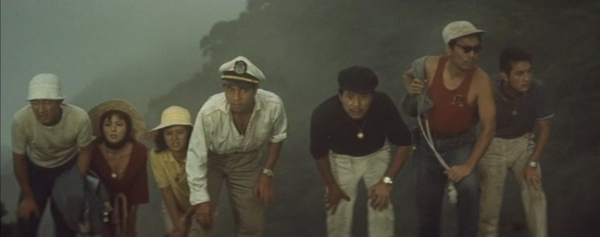MATANGO (aka ATTACK OF THE MUSHROOM PEOPLE) (aka FUNGUS OF TERROR) (Ishirō Honda, 1963)
Japan Society
333 East 47th St. at First Ave.
Friday, January 23, 7:00
Festival runs monthly through February 20
212-715-1258
www.japansociety.org
 How can you go wrong with a Japanese monster movie with such alternate titles as Attack of the Mushroom People and Fungus of Terror, directed by the man who gave us Godzilla, Rodan, Destroy All Monsters, and The Human Vapor? Well, you can’t. Ishirō Honda’s 1963 cult classic, Matango, is a postwar apocalyptic tale that evokes Lord of the Flies, The Thing, Invasion of the Body Snatchers, and Antonioni’s L’Avventura while predicting Lost and, yes, Gilligan’s Island. Written by frequent Honda collaborator Takeshi Shimura based on William Hope Hodgson’s 1907 short story “The Voice in the Night” (which was included in the 1958 compilation Alfred Hitchcock Presents: 12 Stories They Wouldn’t Let Me Do on TV), Matango also has its fair share of social commentary, as seven characters on a yachting outing end up stranded on a seemingly deserted island: the first mate, Senzô (Kenji Sahara), the skipper, Naoyuki (Hiroshi Koizumi), the wealthy Kasai (Yoshio Tsuchiya), the writer, Yoshida (Hiroshi Tachikawa), the sultry singer, Mami (Kumi Mizuno), the professor, Kenji (Akira Kubo), and the mousy Akiko (Miki Yashiro). Mushrooms are thriving on the island, but it’s best not to eat them, because they are not exactly the psychedelic fungi beloved by hippies in the mod movies of the ’60s. The film touches on jealousy, resentment, loneliness, hunger, and sanity in the nuclear age, with special effects (courtesy of Eiji Tsuburaya) that make the early years of Doctor Who — and Gilligan’s Island itself —seem like a technological marvel.
How can you go wrong with a Japanese monster movie with such alternate titles as Attack of the Mushroom People and Fungus of Terror, directed by the man who gave us Godzilla, Rodan, Destroy All Monsters, and The Human Vapor? Well, you can’t. Ishirō Honda’s 1963 cult classic, Matango, is a postwar apocalyptic tale that evokes Lord of the Flies, The Thing, Invasion of the Body Snatchers, and Antonioni’s L’Avventura while predicting Lost and, yes, Gilligan’s Island. Written by frequent Honda collaborator Takeshi Shimura based on William Hope Hodgson’s 1907 short story “The Voice in the Night” (which was included in the 1958 compilation Alfred Hitchcock Presents: 12 Stories They Wouldn’t Let Me Do on TV), Matango also has its fair share of social commentary, as seven characters on a yachting outing end up stranded on a seemingly deserted island: the first mate, Senzô (Kenji Sahara), the skipper, Naoyuki (Hiroshi Koizumi), the wealthy Kasai (Yoshio Tsuchiya), the writer, Yoshida (Hiroshi Tachikawa), the sultry singer, Mami (Kumi Mizuno), the professor, Kenji (Akira Kubo), and the mousy Akiko (Miki Yashiro). Mushrooms are thriving on the island, but it’s best not to eat them, because they are not exactly the psychedelic fungi beloved by hippies in the mod movies of the ’60s. The film touches on jealousy, resentment, loneliness, hunger, and sanity in the nuclear age, with special effects (courtesy of Eiji Tsuburaya) that make the early years of Doctor Who — and Gilligan’s Island itself —seem like a technological marvel.
Matango is not so much scary these days as just an absolute hoot, a kind of minor time capsule treasure that you can check out on January 23 at 7:00 when Japan Society screens it as part of its monthly film series “The Dark Side of the Sun: John Zorn on Japanese Cinema,” which concludes in March with the U.S. premiere of the made-for-television Nagisa Oshima’s It’s Me Here, Bellett, preceded by eight shorts by Osamu Tezuka. “I had been a huge fan of Japanese music, art, and film since the early 1960s, but late night Tokyo TV provided a peek into an entirely different world outside the classic art film masterpieces of Ozu, Mizoguchi, Kurosawa, and Inagaki,” experimental musician and composer and downtown fixture Zorn explains in his curator statement. “It was a revelation to discover that Oshima’s Cruel Story of Youth and The Sun’s Burial were not so much an isolated vision but actually two examples of an entire cinematic genre, and that directors like Seijun Suzuki, Kinji Fukasaku, Toshio Masuda, Yasuzo Masumura, Teruo Ishii, and others had made incredible and uncompromising films that spoke as much about the Japanese psyche as origami, noh theater, or the tea ceremony ever had. . . . For me, the experimental, adventurous, and uncompromising side of any society is often the home of the deepest truths, and these films each hold their truths to an often uncomfortable extreme. I hope you enjoy the (occasionally blinding) intensity of ‘The Dark Side of the Sun.’”
